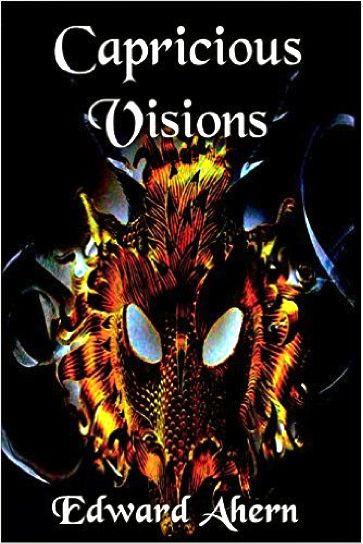Edward Ahern, Capricious Visions
reviewed by Alison McBain

Capricious Visions Publisher: Gnome on Pig Productions Date: August 23, 2016 Paperback: 280 pp. ISBN: 1365338037: 9781365338038 |
Before I met Edward Ahern in person, my first introduction to his writing was in the magazine The Devilfish Review. While Devilfish always has a wonderful collection of prose and poetry, one story that stuck in my mind was Mr. Ahern’s “Pest Hag” in issue 11. It was wonderful to read the story again in the beginning of Capricious Visions, a collection of Mr. Ahern’s short stories recently released by Gnome on Pig Productions.
In the story, Dr. Norberg is a helpless observer when a sudden outbreak of a flesh-eating disease puts the city into a panic. He can’t find the source of the outbreak, and several of his patients become infected and die. His grandmother warns him about a Norwegian legend of a witch who spreads disease, like a supernatural Typhoid Mary. Dr. Norberg dismisses it as only a superstition, and his grandmother agrees — but she reminds him that people can spread disease, and if he finds out how the disease is being spread, then he will find out how to stop it.
Without giving away the ending, it’s a page-turner from the first sentence to the last, with a nicely satisfying conclusion. It’s a good representative of the short stories as a whole in Capricious Visions — the tales are of a satisfying complexity, often mixing old legends with the modern day, and told in a straightforward style. They range from magical realism all the way to high fantasy, from creeping tales of horror to straight-out gorefests. Almost all the stories have been published previously, although there are a couple of new ones thrown in also.
I found the level of writing quite high. My one criticism, if I had to have one, would be that I felt the endings to one or two felt as if they came a bit too soon; I would have liked to see more. But it’s not a bad thing to want more from a short story or even a novel. It reminds me of the quote by Neil Gaiman: “I think I’d just remind people of the power of stories, and why they exist in the first place. I’d like to put up the four words that anyone telling a story wants to hear. The ones that show that it’s working, and that pages will be turned: ‘And then what happened?’”
There were so many good stories in the collection that it is hard to pick out my favorites, although there were a few that resonated with me in particular. “Pest Hag,” which I've already mentioned, was one. Another one was “Touching Memory,” a flash fiction about a gruesome new way to immortalize a loved one. It was one of the stories with a strong touch of humor, so it was a good change of pace.
“After Taste” was a unique take on the classic ghost story, and “The Judas Goat” does a great job of combining classic Egyptian mythology with the modern day. You’ll find yourself rooting against the main character in “The Initiate,” and hoping for the best for the characters in “Fleurs du Mal.” And the level of worldbuilding was impressive for a short story in “Notes on the Pestilence.”
But I must say that my favorite story in the whole collection had to be “The Dogfisherman.” It combines all the strongest elements of a well-told story — fantastic description and detail, sympathetic characters, a unique setup, and just the right touch of mystery.
Two older fishermen, Danny and Ralph, have known each other a long time from fishing at the same spot. One night, Ralph tells Danny he needs to show him something. What he shows him is a group of dogfish — long, eel-like sharks with sharp teeth — who hang around every time he comes to the water. They point him to the best fishing, and he gives them some of his catch to eat. Ralph disappears a short time later, and Danny is fishing by himself in their usual spot when a large dogfish comes up to him. Danny starts to do as Ralph did, and becomes a friend to the dogfish. But the fish can’t tell him what has happened to Ralph; he only finds out when the police give him a call.
The story is told in such a beautiful, literary fashion, a leisurely-paced narrative that culminates in a final and poignant image. Although, in my opinion, I think it’s the star of the work, this is a really strong collection as a whole, with stories to appeal to all readers of speculative fiction.
Mr. Ahern’s greatest strengths are in his pacing and suspense. Whether used for fantasy or for horror, there is always an element of mystery that keeps the reader turning the page. And like any good story, a lot of the appeal lies in what is unsaid — Ahern does a masterful job of treading the fine line between implication and suggestion, keeping the reader guessing up until the end.
All in all, Capricious Visions is a collection I would recommend, especially to lovers of horror and fantasy. I enjoyed reading it, and I hope you will, too.
Copyright © 2016 by Alison McBain

